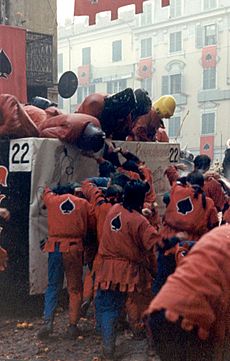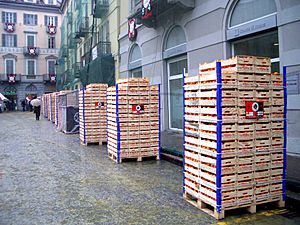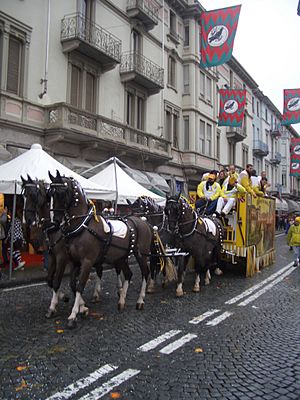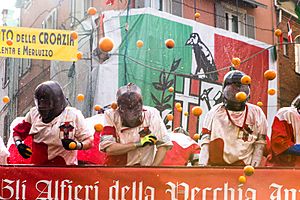Carnival of Ivrea facts for kids
The Carnival of Ivrea is a fun festival held in the city of Ivrea in Northern Italy. It's famous for a special tradition: throwing oranges between different groups of people! This exciting event is known as the "Battle of the Oranges." It's the biggest food fight in Italy and nearby countries.
Contents
The Story Behind the Carnival
The Carnival of Ivrea has a long history. A popular story says the orange battle remembers a time when the city stood up against a mean ruler. This ruler was often called a tyrant. Legend says a brave young woman, often a miller's daughter, killed the tyrant. After this, the people of Ivrea attacked and burned his palace.
Every year, a young girl is chosen to play the part of Violetta. She is the brave miller's daughter from the story. The citizens celebrate their freedom with the "Battle of the Oranges." Teams of aranceri (orange throwers) on foot throw oranges. These oranges represent the old weapons and stones used in the rebellion. They throw them at aranceri riding in carts. The people in carts represent the tyrant's soldiers.
Some of the oldest parts of the Ivrea Carnival include a big bonfire. These parts are like ancient celebrations. They mark the end of winter and the start of spring. The battle was paused from 2021, but it came back in 2023. It was also stopped during the World Wars.
How the Celebration Works
The main part of the celebration is the "Battle of the Oranges." Thousands of people from Ivrea take part. They are split into nine fighting teams. These teams throw oranges at each other with a lot of energy! The battle happens during the traditional carnival days: Sunday, Monday, and Tuesday. The Carnival usually takes place in February, sometimes in March. It ends on the night of Shrove Tuesday with a quiet funeral march.
At the end of this march, the "General" says goodbye to everyone. He uses a special phrase in the local language. It means, "we'll see each other on Thursday at one." This refers to the Thursday when the next year's Carnival will begin.
The Brave Miller's Daughter
One special citizen is chosen each year to be the Mugnaia. This means "miller's daughter." The legend says that Ivrea was once ruled by a cruel duke. After the miller's daughter, Violetta, got married, she bravely killed the duke. This act started a revolution. The people then destroyed the duke's castle. Today, the carriages in the battle are said to represent the duke's army. The orange throwers represent the brave revolutionaries.
At first, people threw beans, then apples. Later, in the 1800s, oranges became the symbol. They represented the stones thrown at the king's castle to break it down. It's a bit of a mystery why oranges are used. Oranges don't grow in the Italian Alps where Ivrea is. They have to be brought in from places like Sicily. In 1994, about 265,000 kilograms (584,225 pounds) of oranges were used. Most of these were extra oranges from the winter harvest in southern Italy.
The Orange-Throwing Teams
Nine historical teams of "aranceri" (orange throwers) fight on foot. They defend Ivrea against the Tyrant's carted soldiers. Here are the teams:
- Aranceri Asso di Picche: They wear red and blue jerseys with a black neck scarf. Their symbol is a single spade. They started in 1947.
- Aranceri della Morte: They wear black jerseys and red pants. Their symbol is a white skull. This team began in 1954.
- Aranceri Tuchini del Borghetto: They have green jerseys, red pants, and a black crow on a white field on their back. They were created in 1964.
- Aranceri degli Scacchi: Their jerseys are black and white checkered. Their symbol is an orange tower. This team also started in 1964.
- Aranceri Pantera Nera: They wear black jerseys with a black panther on a yellow field on the back. They were formed in 1965.
- Aranceri Scorpioni d'Arduino: They have yellow jerseys, green pants, and a black scorpion as their symbol. They began in 1966.
- Aranceri Diavoli: They wear red and yellow jerseys with a red devil. This team was created in 1973.
- Aranceri Mercenari: They have maroon jerseys and yellow pants. Their symbol is a yellow star with maroon swords. They started in 1974.
- Aranceri Credendari: They wear blue jerseys and yellow pants. Their symbol is the Palazzo della Credenza and the town's coat of arms. They were formed in 1985.
See also
- Gorehabba – a cow dung fight in India
- La Tomatina – a tomato fight in Spain
- Pidakala War– a cow dung fight in India
- Songkran – a water fight festival in Thailand






